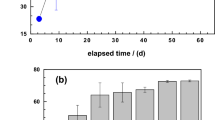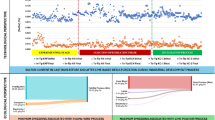Abstract
Scrap Cu-modified cast iron (CMCI) is a potent material for the reduction of 2,4-dinitrotoluene (2,4-DNT) by a surface-mediated reaction. However, the effects of operational parameters and common ions on its reduction and final rate are unknown. Results show that the 2,4-DNT reduction was significantly affected by Cu:Fe mass ratio and the optimum m(Cu:Fe) was 0.25 %. The slight pH-dependent trend of 2,4-DNT reduction by CMCI was observed at pH 3 to 11, and the maximum end product, 2,4-diaminotoluene (2,4-DAT), was generated at pH 7. Dissolved oxygen (DO) in the water reduced the 2,4-DNT degradation and the formation of 2,4-DAT. CMCI effectively treated high concentrations of 2,4-DNT (60 to 150 mg L−1). In addition, varying the concentration of (NH4)2SO4 from 0.001 to 0.1 mol L−1 improved the efficiency of the reduction process. The green rust-like corrosion products (GR-SO4 2−) were also effective for 2,4-DNT reduction, in which Na2CO3 (0.01 to 0.2 mol L−1) significantly inhibited this reduction. The repeated-use efficiency of CMCI was also inhibited. Moreover, 2,4-DNT and its products, such as 4A2NT, 2A4NT, and 2,4-DAT, produced mass imbalance (<35 %). Hydrolysis of Fe3+ and CO3 2− leading to the generation of Fe(OH)3 and conversion to FeOOH that precipitated on the surface and strongly adsorbed the products of reduction caused the inhibition of CO3 2−. The 2,4-DNT reduction by CMCI could be described by pseudo-first-order kinetics. The operational conditions and common ions affected the 2,4-DNT reduction and its products by enhancing the corrosion of iron or accumulating a passive oxide film on the reactivity sites.







Similar content being viewed by others
References
Agrawal A, Ferguson WJ, Gardner BO, Christ JA, Bandstra JZ, Tratnyek PG (2002) Effects of carbonate species on the kinetics of dechlorination of 1,1,1-trichloroethane by zero-valent iron. Environ Sci Technol 36(20):4326–4333
Anipsitakis GP, Dionysiou DD (2003) Degradation of organic contaminants in water with sulfate radicals generated by the conjunction of peroxymonosulfate with cobalt. Environ Sci Technol 37(20):4790–4797
Cundy AB, Hopkinson L, Whitby RL (2008) Use of iron-based technologies in contaminated land and groundwater remediation: a review. Sci Total Environ 400(1-3):42–51
Devlin JF, Allin KO (2005) Major anion effects on the kinetics and reactivity of granular iron in glass-encased magnet batch reactor experiments. Environ Sci Technol 39(6):1868–1874
Fan JH, Ma LM (2009) The pretreatment by the Fe–Cu process for enhancing biological degradability of the mixed wastewater. J Hazard Mater 164(2-3):1392–1397
Fan JH, Wang HW, Wu DL, Ma LM (2010) Effects of electrolytes on the reduction of 2,4-dinitrotoluene by zero-valent iron. J Chem Technol Biotechnol 85(8):1117–1121
Fan JH, Wang HW, Wu DL, Liu ZG, Ma LM (2011) Scrap cast iron and CMCI for reductive degradation of 2,4-dinitrotoluene. J Chem Technol Biotechnol 86(10):1295–1302
Hansen HCB, Susanne G, Marianne E (2001) Kinetics of nitrate reduction by green rust—Effects of interlayer anion and Fe(II): Fe(III) ratio. Appl Clay Sci 18(1/2):81–91
Hsu JC, Lin CJ, Liao CH, Chen ST (2008) Evaluation of the multiple-ion completion in the adsorption of As(V) onto reclaimed iron-oxide coated sands by fractional factorial design. Chemosphere 72(7):1049–1055
Jafarpour B, Imhoff PT, Chiu PC (2005) Quantification and modelling of 2,4-dinitrotoluene reduction with high-purity and cast iron. J Contam Hydrol 76(1-2):87–107
Kim JD, Pyun SI (1996) The effects of applied potential and chloride ion on the repassivation kinetics of pure iron. Corros Sci 38(7):1093–1102
Klausen J, Tröber S, Haderlein SB, Schwarzenbach RP (1995) Reduction of substituted nitrobenzenes by Fe(II) in aqueous mineral suspension. Environ Sci Technol 29(9):2396–2404
Klausen J, Ranke J, Schwarzenbach RP (2001) Influence of solution composition and column aging on the reduction of nitroaromatic compounds by zero-valent iron. Chemosphere 44(4):511–517
Kohn T, Kane SR, Fairbrother DH, Roberts AL (2003) Investigation of the inhibitory effect of silica on the degradation of 1,1,1-trichloroethane by granular iron. Environ Sci Technol 37(24):5806–5812
Lee JY, Hozalski RM, Arnold WA (2007) Effects of dissolved oxygen and iron aging on the reduction of trichloronitromethane, trichloracetonitrile, and trichloropropanone. Chemosphere 66(11):2127–2135
Li T, Farrell J (2000) Reductive dechlorination of trichloroethene and carbon tetrachloride using iron and palladized-iron cathodes. Environ Sci Technol 34(1):173–179
Lin YH, Tseng HH, Wey MY, Lin MD (2010) Characteristics of two types of stabilized nano zero-valent iron and transport in porous media. Sci Total Environ 408(10):2260–2267
Ma LM, Zhang WX (2008) Enhanced biological treatment of industrial wastewater with bimetal zero-valent iron. Environ Sci Technol 42(15):5384–5389
Ma CA, Zhang WK, Huang H, Gan YP (1999) Study on electrochemical reduction properties of bitrobenzene. Electrochemistry 5(4):395–399 (in chinese)
Mantha R, Taylor KE, Biswas N (2001) A continuous system for Fe0 reduction of nitrobenzene in synthetic wastewater. Environ Sci Technol 35(15):3231–3236
Matheson LJ, Tratnyek PG (1994) Reductive dehalogenation of chlorinated methanes by iron metal. Environ Sci Technol 28(12):2045–2053
Mu Y, Yu HQ, Zheng JC, Zhang SJ, Sheng GP (2004) Reductive degradation of nitrobenzene in aqueous solution by zero-valent iron. Chemosphere 54(7):789–794
National Environmental Protection Agency (2002) Monitoring and analysing methods of water supply and wastewater (The 4th edition). Beijing: Chinese Environmental Science Press
Odziemkowski M S, Gillham R W (1997) Surface redox reactions on commercial grade granular iron (steel) and their influence on the reductive dechlorination of solvent. Micro Raman Spectroscopic Studies. In: 213th ACS National Meeting: Division of environmental chemistry preprints of extended abstracts, San Francisco, CA. 177–180
Odziemkowski MS, Schuhmacher TT, Gillham RW, Reardon EJ (1998) Mechanism of oxide film formation on iron in simulating groundwater solutions: Raman spectroscopic studies. Corros Sci 40(2&3):371–389
Oh SY, Cha DK, Kim BJ, Chiu PC (2002) Effect of adsorption to element iron on the transformation of 2,4,6-trinitrotoluene and hexahydro-1,3,5-trinitro-1,3,5-triazine in solution. Environ Toxicol Chem 21(7):1384–1389
Otte K, Schmah WW, Pentcheva R (2012) Density functional theory study of water adsorption on FeOOH surfaces. Surf Sci 606:1623–1632
Pecher K (1997) Transformation of polyhalogenated alkanes in suspensions of ferrous iron and iron oxides. In: 213th ACS National Meeting: Division of environmental chemistry preprints of extended abstracts, San Francisco, CA. 185–186
Schrick B, Blough JL, Jones AD, Mallouk TE (2002) Hydrodechlorination of trichloroethylene to hydrocarbons using bimetallic nickel-iron nanoparticles. Chem Mater 14(12):5140–5147
Siantar DP, Schreier CG, Chou S-S, Reinhard M (1996) Treatment of 1,2-dibromo-3-chloropropane and nitrate-contaminated water with zero-valent iron or hydrogen/palladium catalysts. Water Res 30(10):2315–2322
Su CM, Puls RW (2004) Nitrate reduction by zero-valent iron: Effects of formate, oxalate, citrate, chloride, sulfate, borate, and phosphate. Environ Sci Technol 38(9):2715–2720
Tang XH, Gan FX, Qiao SY (1998) The application of cast iron to the treatment of industrial wastewater. Ind Water Treat 18(6):4–7 (in Chinese)
Uludag-Demirer S, Bowers AR (2003) Effects of surface oxidation and oxygen on the removal of trichloroethylene from the gas phase using elemental iron. Water Air Soil Poll 142:229–242
Xu WY, Gao TY, Fan JH (2005) Reduction of nitrobenzene by the catalyzed Fe–Cu process. J Hazard Mater 123(1-3):232–241
Yu J, Qin XP, Gao L et al (2009) Application of internal electrolysis in treatment of organic wastewater. China Water Wastewater 25(12):12–15, (in Chinese) 19
Zhang L, Arnold WA, Hozalski RM (2004) Kinetics of haloacetic acid reactions with Fe(0). Environ Sci Technol 38(24):6881–6889
Acknowledgments
The authors extend their gratitude to Bing Han for her assistance on the laboratory work. We acknowledge the financial support given by the National Natural Science Foundation of China (No. 51108330), State Key Laboratory of Pollution Control and Resource Reuse Foundation (No. PCRRY11005) and the National Science and Technology Support Program (2013BAC01B01).
Author information
Authors and Affiliations
Corresponding author
Additional information
Responsible editor: Philippe Garrigues
Rights and permissions
About this article
Cite this article
Fan, JH., Wang, HW. Effects of operational parameters and common ions on the reduction of 2,4-dinitrotoluene by scrap copper-modified cast iron. Environ Sci Pollut Res 22, 9932–9942 (2015). https://doi.org/10.1007/s11356-015-4143-1
Received:
Accepted:
Published:
Issue Date:
DOI: https://doi.org/10.1007/s11356-015-4143-1




